Milk is an excellent ingredient because of its widespread availability and diversity of flavors. For example, it’s just as at home in a savory hot chowder as it is in a sweet cold ice cream. However, there will be many times when you simply can’t keep milk. Maybe you don’t have access to storage space, a fridge, or the ability to go to the store regularly for fresh milk. In these cases, it might be best to use powdered milk.

The main advantage of powdered milk is its extensive shelf-life. If you don’t use milk regularly, you may not want to spend money on a whole jug of milk you won’t get to finish before it expires. With powdered milk, you can store it in your cupboard for much longer than fresh liquid milk, using it a bit at a time until you finish it. You also get to save on your fridge storage place.
How to Use Your Powdered Milk?
If you want to use powdered milk, you should be aware that it can be a little different from regular milk. Its unique medium means that its taste can be highly influenced by cooking and recipes. If you want to know a few tricks to get the flavor and consistency you want from powdered milk, here are ten you can try out.
1. Use it in Your Coffee
Many people have taken to using coffee creamers as a replacement for regular milk. This is often because many coffee creamers come in a powdered form and can be easily stored in your cupboard. However, as we’ve mentioned, you can do the same with powdered milk! What’s more, powdered milk is much better for your nutrition and overall health. Milk contains many trace vitamins and minerals your body needs, as well as nutrients like calcium and iodine.
2. Try it in Your Fruit Smoothies
When you think of smoothies, you might think of a milk-based beverage. However, if you’ve taken a look at the modern health movement, you would have noticed that many health-conscious recipes call for fruit blends. You might not typically include milk as it will add too much water to your smooth, so you wouldn’t get to reach your daily fruit intake goals. As powdered milk is simply dehydrated milk, it is more concentrated and can be more easily blended into the water and natural juices of your fruits in a fruit smoothie.
3. Add to Soups and Chowders
Similar to your smoothies, you might not want to add too much milk to these recipes because regular milk includes a notable amount of water. However, with powdered milk, you have the ability to include the delicious taste of milk that will mix with your existing soup base and liquids, without adding to the overall water content. Adding powdered milk to your soups and chowders will lend them a richer, creamier overall taste.
4. Make it Richer Milk With Whole Milk
If you’ve been put off by powdered milk before, it’s likely because the first time you tasted it it was a bit lighter and more watery than the regular milk you have tried before. If this has been your experience, you should try preparing the powdered milk as directed on its packaging, and then adding an additional 25% of whole milk. For example, if you prepared four cups of milk from powdered milk, add a cup of whole milk. This will elevate the taste and make it just a bit richer than you might expect.
5. Use it in Skincare
Milk is well-known for its creaminess. Many have recognized that milk is great for hydrating and moisturizing your skin, taking it upon themselves to create excellent recipes to make it easier to use milk in your skincare regime. Consider using one of these recipes, which often utilizes powdered milk. A great recipe for a face mask using powdered milk includes mixing powdered milk, a few drops of lemon juice, and rose water in small parts until a smooth paste is formed. Apply this liberally across your face, avoiding your eyes and mouth, and let sit for four to five minutes. Rinse it off and you’re done! You should notice a softer and smoother texture to your skin.
6. Make Hot Chocolate Mixes
The problem with most hot chocolate mixes is that you simply can’t control how they come out. Some of you may like very creamy hot chocolate while others may prefer sweet and light hot chocolate. That’s the beauty of making your own hot chocolate mixes. Simple blend cocoa powder, milk powder, and sugar to your desired quantities. Then add water to enjoy or store your mix until you’re ready to use it.
7. Preparing Meats or Fish
If you’re thawing frozen meat or fish to cook, consider letting it thaw with a bit of powdered milk, about a quarter cup of powdered milk per pound of meat or fish. The powdered milk will absorb into the meat or fish and make it have a richer and creamier taste after cooking. It will also remove any unpleasant scent or taste from the food.
8. Add it to the Bath

Milk baths have been a part of European and Middle Eastern culture for a long time, as they believed it to lighten, moisturize, and rejuvenate the skin. If you’re preparing a bath, consider adding just a cup of powdered mix to it, along with your usual soap or oils. This will help your skin feel a bit softer after the bath, as well as add to a soothing and more tactile experience in the bath to unwind.
9. Use it to Cure Spicy Discomfort
If you’ve prepared a particularly spicy meal, consider preparing a jug of milk or setting aside your powdered milk to be ready for use. It is well-known that drinking milk is an excellent way to reduce the effects of eating spicy food. It provides instant relief and can help soothe your irritated tongue and mouth.
10. Prepare Your Own Evaporated Milk
Many recipes call for evaporated milk, but it can be difficult to find evaporated milk that is the right consistency and flavor. Using powdered milk, you can prepare your evaporated milk to be as concentrated as you would like it, by adding more or less powdered milk to taste. Using this method, you may also try making your own whipped cream.
Conclusion
As you can see, there are a lot of ways for you to use powdered milk. There are a lot of nutrients you can get when drinking milk. Make it a habit to drink everyday.
If you want to learn more about preparedness, you can check out How to Get Started in Food Storage, Tying Shoes with Paracord, Emergency Preparedness, Home Defense, and Preparedness Gift for the Kitchen.
Katy Willis is a writer, lifelong homesteader, and master herbalist, master gardener, and canine nutritionist. Katy is a preparedness expert and modern homesteader practicing everyday preparedness, sustainability, and a holistic lifestyle.
She knows how important it is to be prepared for whatever life throws at you, because you just never know what's coming. And preparedness helps you give your family the best chance to thrive in any situation.
Katy is passionate about living naturally, growing food, keeping livestock, foraging, and making and using herbal remedies. Katy is an experienced herbalist and a member of the CMA (Complementary Medical Association).
Her preparedness skills go beyond just being "ready", she's ready to survive the initial disaster, and thrive afterward, too. She grows 100% organic food on roughly 15 acres and raises goats, chickens, and ducks. She also lovingly tends her orchard, where she grows many different fruit trees. And, because she likes to know exactly what she's feeding her family, she's a seasoned from-scratch cook and gluten-free baker.
Katy teaches foraging and environmental education classes, too, including self-sufficient living, modern homesteading, seed saving, and organic vegetable gardening.
Katy helps others learn forgotten skills, including basic survival skills and self-reliance.
She's been published on sites such as MSN, Angi, Home Advisor, Family Handyman, Wealth of Geeks, Readers Digest, and more.
